Looking Glass World
, Dresden
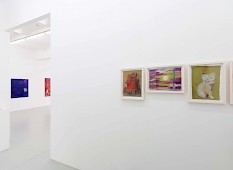
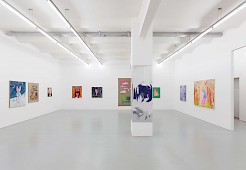
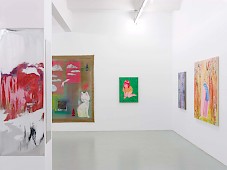
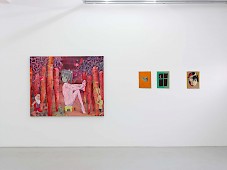
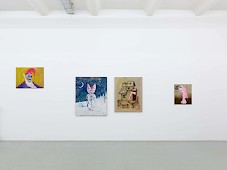
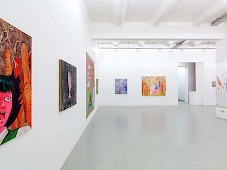
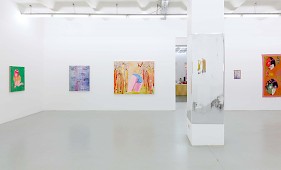
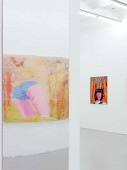
Oversized carrots, Manga girls, fairy tale characters, disconnected body parts, and fragments of surreal landscapes–this other world, which we encounter in the pictures by Martin Mannig, emerges from the intermingling, simultaneity and a constant exchange that takes place between various different levels of reality and a multitude of motifs. Symbolically loaded characters and subjects interact in his images according to an internal logic. This logic often reveals surprising connections that–to the normal spectator–appear as reversals of meaning and plays with expectation. The visually comprehensible narration conceals an even deeper level–a mirror world–behind it, where the categories of “real” and “fantastical” bleed into each other and can no longer be cognitively differentiated.
Here, Martin Mannig’s figures lead a life of their own. They move not only within the space of one image, but wander from one canvas to another. This circulation creates a multidimensional, often ambivalent cosmos, of which we see only single details, brief snapshots.
Martin Mannig’s working method has an experimental character. His figures and motifs do not arise from a concrete plan but are born in the process of painting. There is no consistent order within, or imposed on top of, the images. They confront us with simple pictorial components, like drawings or sketches on a wall. As an artist, Mannig works with the surface of the image, and this becomes a window into another world.
This world does not just challenge our normal associative processes but also pushes us beyond our understanding of reality. It confronts the viewer with the question: where did what we are seeing occur? In the outside world or in a mental space? In this way, his images lead the viewer to explore how far his powers of imagination can take him if no conventional boundaries are put in place.
Martin Mannig’s pictures provide the occasion for diverging thoughts. It is this ability to see one and the same thing from very different angles, which is the greatest loss as time passes. Mannig’s painting opens up access to a world behind the mirror, where reality is able to be perpetually and boundlessly transformed.
Überdimensionale Möhren, Mangamädchen, Märchenfiguren, vereinzelte Körperteile und Fragmente surrealer Landschaften–eine andere Welt, der wir auf den Bildern von Martin Mannig begegnen, entsteht aus Verflechtung, Gleichzeitigkeit und permanentem Austausch von mehreren Motiven und Realitätsebenen. Symbolträchtige Figuren und Sujets agieren auf dem Bild nach einer inneren Logik, ergeben dabei oft überraschende Verknüpfungen, die aus der gewohnten Sicht als Umkehrung von Bedeutungen und Spiel mit Erwartungen vorkommen. Hinter der visuell erschließbaren Narration verbirgt
sich jedoch eine tiefere Ebene–die Spiegelwelt, in der die Kategorien „wirklich“ und „phantastisch“ ineinander übergehen und nicht mehr kognitiv erfassbar sind.Hier führen Martin Mannigs Figuren ein Eigenleben. Sie bewegen sich nicht nur innerhalb eines Bildes, sondern wandern auch von einer Leinwand zur anderen. Diese Zirkulation bildet einen vielschichtigen, oft ambivalenten Kosmos, von dem wir jedes Mal nur einzelne Ausschnitte, kurze Schnappschüsse zu sehen bekommen.
Martin Mannigs Arbeitsweise hat einen experimentellen Charakter. Seine Figuren und Motive entstehen nicht nach einem konkreten Plan, sondern werden im Prozess des Malens geboren. Es gibt keine geschlossene Ordnung innerhalb oder oberhalb der Bilder. Was auf dem Bild sichtbar wird, sind genauso malerische Elemente, wie Zeichnungen und Skizzen an einer Wand. Als Künstler arbeitet er mit der Bildoberfläche, und sie wird zum Fenster in eine andere Welt.
Diese Welt fordert nicht nur unsere gewöhnlichen assoziativen Vorgänge, sondern auch unser Realitätsverständnis heraus. Konfrontiert mit der Frage: wo entsteht das, was wir sehen–in der Außenwelt oder im Kopf, kann der Betrachter herausfinden, wie weit ihn seine Vorstellungskraft führen kann, wenn ihr keine allgemein legitimierten Grenzen gesetzt werden.
Martin Mannigs Bilder geben Anlass zum divergenten Denken. Das ist die Fähigkeit, ein und dieselbe Sache aus ganz verschiedenen Blickwinkeln sehen zu können, die mit der Zeit zumeist verloren geht. Mannigs Malerei eröffnet uns den Zugang zur Welt hinter den Spiegeln, wo die Wirklichkeit unbegrenzt und endlos wandlungsfähig ist.